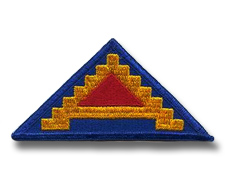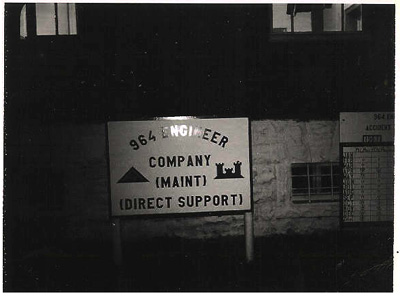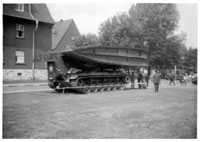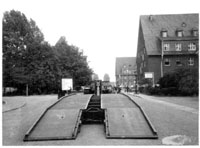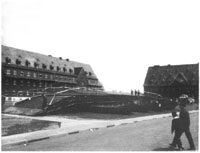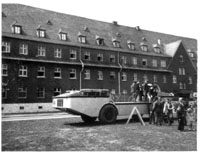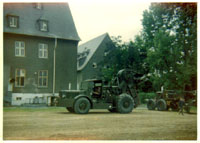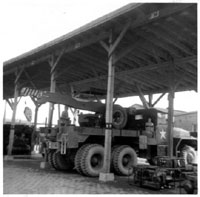| If you do
NOT see the Table of Contents frame to the left of this page, then
Click here to open 'USArmyGermany' frameset |
|||||||||||||||||||||||||||||||||
|
521st
Engineer Group (M&S) |
|||||||||||||||||||||||||||||||||
|
|
|||||||||||||||||||||||||||||||||
|
|||||||||||||||||||||||||||||||||
|
|
|||||||||||||||||||||||||||||||||
| 521st Engineer Group History | |||||||||||||||||||||||||||||||||
| 1955 - 19.. | |||||||||||||||||||||||||||||||||
| (Source: STARS & STRIPES, September 30, 1961) | |||||||||||||||||||||||||||||||||
| The 521st Engineer Group is headquartered in Kaiserslautern. CO is Col Frank A. Camm. The 521st Engineer Gp was moved, less personnel and equipment, from Chinon, Korea, to Kaiserslautern, Germany on Feb 1, 1955 to replace Hq/Hq Company, 403rd Engineer Group. The unit is responsible for engineer-related logistical planning, requirements forecasting, management of stocks, procurement of engineer repair parts and supplies in support of 7th Army, and field maintenance of engineer equipment. Maintenance and supply support is provided for 18,000 major items of engineer equipment. Command supervision includes Specialized equipment operated by the Group includes mobile supply and maintenance shops and vans. The Groups has seven engineer supply points and six engineer field maintenance shops scattered throughout Western Germany to provide 24-hour maintenance for high priority missile units. Utilizing the electronic communications and electronic accounting means of the MASS Program has allowed the Group to pioneer and perfect modern techiques of mobilr maintenance anmd flexible support. |
|||||||||||||||||||||||||||||||||
| If you have more
information on the history or organization of the 521st Engr Gp, please
contact me |
|||||||||||||||||||||||||||||||||
|
|
|||||||||||||||||||||||||||||||||
| (Source: NOTES, May 1965; STATION LIST, 31 March 1965) | |||||||||||||||||||||||||||||||||
| The 521st Engineer Group has nine subordinate units assigned to it. | |||||||||||||||||||||||||||||||||
| ORGANIZATION (May 1965): | |||||||||||||||||||||||||||||||||
|
|||||||||||||||||||||||||||||||||
|
|
|||||||||||||||||||||||||||||||||
| 24th Engineer Platoon (Map Depot) | |||||||||||||||||||||||||||||||||
| 1958 | |||||||||||||||||||||||||||||||||
| (Source: STARS & STRIPES, July 11, 1958) | |||||||||||||||||||||||||||||||||
| The 24th Engineer Platoon in Kaiserslautern serves as the 7th Army Map Depot. CO of the unit is 1st Lt William R. Roe, Jr. There are 28 soldiers assigned to the 24th. The mission of the platoon is to receive, store, and safeguard maps for the 7th US Army. Administratively, the 24th Engr Pltn falls under the 7th Army Support Command (under Brig Gen Stephen M. Mellnik). Operationally, it reports to the 7th Army Engineer Command. Most of the maps stored at the Map Depot were reproduced at the USAREUR Map Depot (524th Engr Co (TOPO)) in Schwetzingen. urce |
|||||||||||||||||||||||||||||||||
| 53rd Engineer Company | |||||||||||||||||||||||||||||||||
| 1956 | |||||||||||||||||||||||||||||||||
| (Source: Email from Jim Huffman, Kornwestheim, 1956-59) | |||||||||||||||||||||||||||||||||
| I was a member of the 53rd Engineer Co (Supply Point) from 7/56 to 1/59. During that time the 53rd and also the 24th Engineer Co (Field Maintenance) were part of the 521st Engr Gp (Maint & Supply). Both were located in Ludendorff Kaserne (but this post was under the 540th Engr Gp Cmbt) that included 38th (Panel Bridge) & 503rd (Light Equipment), Kornwestheim Germany. Both had a platoon in Dachau KZ. In 1958 operations of both companies were combined, the 53rd being stationed at Dachau and the 24th at Kornwestheim. The 53rd was formed during WW2, served in South Pacific under a different name. It was sent to Nam & later the name changed to 53rd Supply Co. Eventually the unit was deactivated. The 521st Engr Gp had other units such as: field maintenance, depot, parts depot, topo. I would like to find out more about Ludendorff Kaserne, like when was it built & what German units used it? As per current maps I've seen, it seems that it has been razed for development, but not sure. From 1956 to 58 the units on base were: The 24th & 53rd were part of 521st. A sign over the main gate said "Home of the Engineers". The 540th Engr Gp had an airfield (small) near Pattonville; it is still on the maps. Probably ex-Luftwaffe for defense of Stuttgart? Jim Huffman |
|||||||||||||||||||||||||||||||||
|
|
|||||||||||||||||||||||||||||||||
| 261st Engineer Company | |||||||||||||||||||||||||||||||||
| 1956 | |||||||||||||||||||||||||||||||||
| (Source: Email from Walter Weil) | |||||||||||||||||||||||||||||||||
| I was assigned to the 261st. Engineer Company from Sept. 1959 to October 1961.
We were located in Furth, Germany, a suburb of Nurenburg. We were a 4th echlon engineer maintenance and supply company that also ran the Engineer Supply Point at Graf. |
|||||||||||||||||||||||||||||||||
| 1961 | |||||||||||||||||||||||||||||||||
| (Source: Email from Danny J. Cavett) | |||||||||||||||||||||||||||||||||
| I was stationed at W. O. Darby Kaserine, Furth, Gremany with the 261st Engineer Company, Field Support, 1961 thru July 1963.
I worked as a diesel mechanic on generators used on the missile sites. I was lucky enough to take a vacation a few years ago and return to Germany. The kaserne is now closed. Does anyone know what happened to the 261st? de-activated, moved?? I read the recollections of Robert Bowman and his time in Germany. He stated that he arrived in Germany in 1961 and went through the 261st Eng. Co. on his way to a permanent assignment. I was assigned at the 261st. at that time having arrived there the first week of February of 1961 and left in July of 1963. I also was a diesel mechanic with the same MOS that he had and worked on a emergency repair team as he did. As you know the 261st. was part of the 7th Army. The company was 3rd echlon field support engineer company. We had an Engineering Equipment Supply and Lumber supply platoon plus two maintance platoons. I was assigned to the second maintance platoon and worked with the emergency repair team working on the generators that were used on the HAWK missle sites around Nuernberg. These Generators were primarily the larger units. 400 volt 400 cycle used for radar and the control vans. We did work on some 120 volt 60 cycle units used for communications. The two maintance platoons primarily worked on heavy equipment, Dozers, Graders, Trenchers, ect. |
|||||||||||||||||||||||||||||||||
| 964th Engineer Company | |||||||||||||||||||||||||||||||||
| (Source: Email from Robert Bowman, Schwetzingen, 1961-64) | |||||||||||||||||||||||||||||||||
| Click here to access Bob's Photo Gallery Page (Page 10) Right off I do not have any ideas of who our higher headquarters was. I always thought that we were part of the 7th Army. That is all they ever told us. I had never heard of the 403rd Engineers Group either until I was it on your web page. I do have old polaroid pics of our company at Tompkins Barracks and of our shop area. That was one of the things I did while I was other there. I had alot of free time to take pictures of our place so I could look back and remember at a later date. I also never knew of any association relating to the 964th. I had heard that after I got out that the company was broken up and then sent all over Germany. I never did care because I was going home and that was all I cared about. I will start this way. About one month before I graduated in 1961 I had heard that the Army was offering a program to the recent graduates. I wanted to go into the Army as there was no work in my home town of Oroville, Washington at that time unless one wanted to make a career of picking apples. I had a better plan so my folks took me to Okanagon, Washington and I met there with a Sargeant Joe Matherly. He was the recruiting Sergeant. He stated that the Army had a program whereby they could guarantee the new enlistee three things. 1. Your chose of place for basic training. I chose Fort Ord, California. 2. Your chose of place for your military school. I chose Fort Belvoir, Virginia for the diesel engine repair course that I wanted to take. The MOS (Military Occupational Specialty) at the time was 623.10. It was later changed to 622.10 when I got to the 964th. 3. I wanted to go the Germany and that is exactly where they sent me. It took 9 days on the USNS Patch. This was a Navy troop carrier. I remember getting KP the whole time handing out milk to 5,000 guys who were on board. Once I arrived in Germany I was trucked with 8 others, I think, to a company called the 261st Engineer Company stationed at Nurnberg for about 7 weeks. This was in the winter of 1961 and it was very cold to say the least. We just sat around waitng for permanent orders and did very little. Very shortly the orders were cut and we were loaded up and hauled in the back of a duece and a half half way across Germany. Each man would be dropped off at a company along the way. |
|||||||||||||||||||||||||||||||||
|
|||||||||||||||||||||||||||||||||
| My job was to repair diesel engines in generator sets as well as work on these engines in cranes, road graders and amphib boats. These boats were the ones that had 4 big rubber tires and would float at the same time and were used to haul troops across rivers. Most of the diesel engine were 3-71,4-71,6-71,12V71 Detroit 2 cycles power plants. The Generators sets had two types of Cummins diesel engines in them. They were the JSGA 601 and the JS6Gs. We would replace head gaskets, injectors, starters, static exciters, water pumps, oil coolers and the PT fuel pumps. At some time we would also install completely new engines. I remember that we could order a new engine that afternoon and the next morning it was at our shop. We were told that these were flown directly from the factory in the states via a Blue Streak ordering system. At any rate the engine was in a box with labels stating made in the USA. These were always brand new and smelled like it. After I was there for about 8 months I became part of a 8 man emergency repair team. We were assigned a Dodge 3/4 ton pickup with a flat head six and a 4 speed trannie. We would get called at all hours of the day and night and make calls to about 6 different companies within 100 miles of our company. We would perform the work that was needed to get these generator sets back in order. I remember that in the summer time it was great but the winters of 1962 and 1963 were unbearable. It only got to 25 and 35 below for those two years. These generator sets would be placed under a little roofed shed out in the open on some high hill top and the wind could wreak havoc on you. We would work out there until we got these sets running again. This might take 14 hours depending on how many sets needed work. When we got done we would then get the work orders signed by the proper person to prove that we had indeed been doing what we were told to do. Maybe they thought we were out on a drinking binge. We never had the time to do anything but get these generator sets back in order and the sooner the better. I had a buddy of mine with me and both of us were like family. We depended on each other to get the job done. Since he thought that he outranked me I would always get to drive home. He slept and I enjoyed just poking along. I got my discharge papers in June of 1964 and was again put on a troop ship for the trip home. This time it was the USNS Darby. This trip took us 7 days. My main job was guard duty. We were caught, two of us, sleeping under those big vents on the deck of the ship sleeping. I will not go into that. We were at peace then so who would have attacked us anyway. We arrived home and were shipped to Fort Hamilton, New York. I was processed and then they took away alot of my military clothes and then I was handed a Honorable Discharge, given so much money for the trip home, and boarded the Great Northern Railroad Empire Builder towards home. I could probably go into greater detail but it might take three or four more pages. If you wish to hear more I will get my old brain ingaged and try to remember it. I am nearly 60 now and I remember alot of it very clearly. I had a good time there, met alot of great guys, had a real good time, drank alot of german beer, took alot of pictures but longed the time when I could get back to the USA and see my girl that was in Beckley, West Virginia who had been writing to me. I do wish that I could find out where alot of the gang is today but so far it has been very hard. One of them is only 30 miles away and when I called him about three weeks ago he told me he could not recall anything about our time over there. He was totally amazed by how much I could remember. Robert N. Bowman Additional information: I have recalled that the company in the middle of our building there at Tompkins was not the 24th but rather the 68th Engineers. They were a topo (Map) group and we did not get involved with them what so ever. It is so strange I cannot even recall any of the men I knew except the close ones that I worked with. These were the guys on the ER teams. We were family because we stayed in the same rooms together. We were also excused from all duties such as guard duty or KP. We could come and go and no one rarely questioned what we did. As long as the work got done is all that mattered. We looked at the pictures of Tompkins Barracks and the very first one brings back very fond memories. I often wonder what it looks like now being that I was there almost 40 years ago. It would be nice to be able to revisit the place and see how it has changed. Robert N. Bowman |
|||||||||||||||||||||||||||||||||
| (Source: Email from William Miller, 964th Engr Co, 1962-63) | |||||||||||||||||||||||||||||||||
I served in the 521st Engr Gp and the 964th Engineer Co from Jan 1962 to Dec 1963. In regards to the 964th I will try to relay some of the memories I have of my time in the 964th.
The 964th was one of 13 companys of 521st Engineer Group. Supporting about 5000 pieces of engineer equipment which consisted of generators from 5kw to 75kw, bulldozers, cranes, frontend-loaders, graders, rock crushers, rollers, and other construction equipment. This included special equipment such as the French floating bridge, M50 folding bridge, and small boats. I think the company was made up of five platoons. Four maintence and one that contained CQ and motor pool personnel. Each maintence platoon had a deuce and a half with a machine shop installed on it. A three-quarter ton power wagon with a welder and utility body with a large assortment of tools. A five-ton wrecker and a deuce and half with trailer loaded with equipment and 16 ft by 20 ft maintence tent. Each platoon was set up to operate independent of each other.
Most of our work was for other combat and bridge units. We were authorized to do third, fourth, and fifth echelon work. The unit that the equipment was assigned to did first and second echelon work. One of the funnier things of the military life, we were not authorized to work on jeeps and truck because they were ordnance equipment. All though we did work on them at times. I have some photos of some equipment like the folding bridge and rock crusher. I also have a photos of a trip East Berlin which contain pictures of sites like Check Point Charlie and Soviet Cemetery of soldiers killed in the seige of Berlin. Also the east side of Brandenburg Gate and Hitler's bunker.
|
|||||||||||||||||||||||||||||||||
| (Source: Email from John Davis) | |||||||||||||||||||||||||||||||||
| I was very interested in Bob Bowman's photos and personal recollections of the 964th Engineer Co. and Tompkins Barracks. I also served in the 964th in 1963 to 1964. I lived in Long beach California when I got that letter from the draft board inviting me to the Induction Centre in L.A. in the fall of 1961. The 86th was a friendly outfit with scads of machines to practice on. In April each year we went TDY to Camp Drum upstate New York to act as permanent party and repair the havoc that various reserve divisions caused on their annual pilgrimage to play soldiers at Camp Drum. There was not a lot to do off base at Camp Drum with girls being in particularly short supply. I well remember two sisters popularly known as the bobsie twins one had all her front teeth missing and her sister about four, they were a charming pair, but they did look better by the week. Of course a lot of intensive training was also required to be able to drink ever increasing quantities of that old swamp water In the summer of 1963 I was surprised to get orders to go to After a while I was sent to an engine rebuild facility in Furth to attend an OJT training course on overhauling all kinds of diesel engines that powered trailer mounted generator sets used on the many missile sites in Germany. The course lasted for about two weeks and was really good. When I got back to the 964th I was sent to join the 964th Gen Set Repair Detachment in I really wish I could remember the others names, they were all good guys and we got on well together. |
|||||||||||||||||||||||||||||||||
| 68th Engineer Company (Parts Depot) -- 7th Army Project MASS | |||||||||||||||||||||||||||||||||
| 1956 | |||||||||||||||||||||||||||||||||
| (Source: STARS & STRIPES, June 17, 1956) | |||||||||||||||||||||||||||||||||
| The 521st Engineer Group (Maint & Supply) also participated in Project MASS, 7th Army's test of the modern army supply system in the 1950's. The Group activated the 68th Engineer Parts Depot Co at Tompkins Barracks in Schwetzingen on Oct 1, 1956. First of several units of its kind to be formed, the 68th will use 20 vans (2 serve as offices) to store parts and remain 100 percent mobile. This innovation allows the 68th to operate almost anywhere and to evacuate an area immediately. As with other supply units involed in Project MASS, the 68th will submit requisitions by use of a one-line punch card form transmitted via electronic transceiver. CO of the newly formed 68th is Capt Norman Morris. 521st Engr Gp CO is Col John P. McWhorter. Maj Kenneth B.Evans is chief of the maintenance section (HQ 521st Engr Gp) which is responsible for the formation of the 68th Engr Parts Depot Co. |
|||||||||||||||||||||||||||||||||
| 1960 | |||||||||||||||||||||||||||||||||
| (Source: Email from Sidney Presley) | |||||||||||||||||||||||||||||||||
| I was stationed at Tompkins Barracks from July 21, 1960 until December 12, 1962. I was in the 68th Engr. Company, Parts Depot located about 9 Kilometers from Heidelberg, but closer to the small village called Schwetzingen. I remember the Combat Engineer companies -- the 24th, 541st, and the 964th -- were housed directly and perpendicular from the 68th. The area in front of the barracks was the called the quadrangle where retreat and other Army calls were played over a PA system. There was a little chapel to the left of our barracks and the three bridge building units would always trained in the field, and return from Grafenwoehr and other ungodly places, caked with mud, flushed, exhausted and fatigued; while we spent our leisurely days in trailers attached to quonset huts, and periodically performing second echelon maintenance on our tractors at the motor pool. Our unit (68th) was 100 percent mobile, and we rarely went to the field. In the 29 months I was stationed at Tompkins Barracks, I spent just 2 weeks in the field. What luck! Before Germany, basic training; Ft Jackson, SC; schooling at Ft. Knox and Ft. Belvoir, after which I acquired MOS 772.10. Then a train ride to Ft. Dix, NJ from Belvoir, a bus ride to Brooklyn Army Terminal, mustered onto a troop ship, a slow voyage past the Statue of Liberty, then an eight days -- do nothing -- cruise to Southampton, England where we had shore leave. The next morning we proceeding up the channel. Ominously, we billowed through the rough waters of the English Channel, finally arriving at Bremerhaven, Germany, then debarkation; a quick train ride to Heidelberg, where I was picked up by a 3/4 ton and eventually blended in with my new brothers in arms. Ultimately, what great friendships we shared during the time in Deutschland and what great beer they had especially when warmed on the radiators. Yes, I remember the adventure well. |
|||||||||||||||||||||||||||||||||
| 1962 | |||||||||||||||||||||||||||||||||
| (Source: STARS & STRIPES, Jan 10, 1962) | |||||||||||||||||||||||||||||||||
| The 68th Engineer Comany (Parts Depot) is located at Tompkins Bks, Schwetzingen. The company was activated in June 1956 as part of 7th Army's MASS Project. As part of Project MASS, the company is responsible for supporting 7th Army's maintenance of engineer equipment by operating a repair parts depot (receiving, storing and issuing repair parts) and maintaining a mobile status (trailers are combat loaded and ready to roll at a moment's notice). The depot carries approx. 8,000 stock lines and transports them in twenty-three 6-ton vans, 12-ton stake and platform trailers and two 25-ton rear-loading trailers with box-type pallets mounted on them. The 68th employs electrical accounting machines (transceivers). Requests for repair parts are received from the 7th Army stock control center in Zweibruecken. Using IBM stock cards, the company checks for availability (a master locator file is kept in one of the company's vans) and notifies the control center within 24 hours if the item is on hand and ready for issue. The requesting unit can then make arrangements for transportation and pick up the item at the depot. |
|||||||||||||||||||||||||||||||||
| Related Links: |
|||||||||||||||||||||||||||||||||
